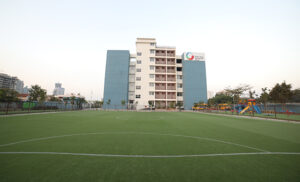Download our FREE Academic Calendar now! 📚 Start your child’s journey to success.
“Success is where preparation and opportunity meet.”
In education, sports scholarships stand as a beacon of hope for aspiring athletes. They not only provide financial assistance but also serve as a launchpad for higher education and potential professional sports careers. However, they also pose unique challenges that demand a delicate equilibrium between sports and academics.
International school scholarship offers a plethora of advantages beyond financial aid. They create pathways for higher education and significantly reduce the financial expenses of students and their families.
Athletic prowess has long been a gateway to educational opportunities for students, paving the way for both personal growth and academic advancement. Sports scholarships, particularly in the global international school Pune, present a unique blend of challenges and advantages. Let’s explore how these scholarships impact students and how they can strike a balance between their athletic commitments and academic pursuits.
Section 1: The Benefits of Sports Scholarships
Global Indian international school scholarship provides a gateway to education for students with exceptional athletic abilities. These scholarships, often offered by international schools, come with substantial financial benefits that alleviate the burden of expensive education.
Beyond the monetary aspect, they create opportunities for higher education that might otherwise be unattainable. Many students gain access to prestigious institutions solely based on their athletic abilities.
Moreover, sports scholarships pave a potential path to professional sports careers. They act as stepping stones for athletes aiming to transition from amateur to professional leagues, offering exposure and development opportunities.
The impact of a school scholarship goes beyond the individual student-athlete. They contribute to the diversity and competitive edge of collegiate sports programs, enriching the sports culture within educational institutions.
Section 2: Challenges Faced by Student-Athletes
Life as a student-athlete is akin to walking a tightrope, balancing intense athletic training with academic rigors. The demanding schedules often lead to time management challenges, with students grappling to allocate sufficient time to both areas of their lives.
Academic challenges are another hurdle. Balancing coursework, exams, and projects alongside extensive training schedules demands a high level of discipline and dedication.
The toll on mental and physical well-being cannot be overlooked. Most of the student-athletes experience heightened stress levels. It may be caused due to the dual pressures of sports and academics, which often lead to burnout and fatigue.
Section 3: Finding the Right Balance
Achieving a harmonious blend between sports and academics requires a strategic approach. Effective time management becomes imperative, with students learning to optimize their schedules to accommodate both aspects of their lives.
Communication skills play a pivotal role. Student-athletes must articulate their needs to coaches and teachers, fostering understanding and support from both sides.
Setting realistic goals acts as a guiding beacon. It helps student-athletes prioritize tasks, set achievable targets, and maintain focus amidst competing demands.
The significance of mentorship and guidance cannot be overstated. Seeking advice from experienced athletes or academic counselors can provide invaluable insights into balancing these dual roles.
Section 4: Navigating the NCAA and College Recruitment Process
Completing the school admission process is a critical step for student-athletes striving to pursue sports at the collegiate level. Here are the seven crucial steps involved in this process:
Step 1: Understanding NCAA Eligibility Requirements
The NCAA has specific eligibility criteria that student-athletes must meet to participate in collegiate sports. These requirements encompass academic standards and eligibility for specific divisions. These standards and criteria dictate a student’s eligibility to compete at the collegiate level.
Step 2: Registering with the NCAA Eligibility Center
Student-athletes aspiring to compete in NCAA-sanctioned sports need to register with the NCAA Eligibility Center. This process involves submitting academic records, standardized test scores (SAT/ACT), and a detailed sports participation history. The Eligibility Center evaluates these documents to determine a student’s eligibility based on NCAA guidelines.
Step 3: Maintaining Academic Eligibility
Academic eligibility is paramount for NCAA participation. Student-athletes must meet minimum GPA requirements and achieve qualifying standardized test scores. Staying on top of academic performance is essential throughout high school to ensure eligibility for college sports.
Step 4: Showcasing Athletic Talent
Beyond meeting academic standards, showcasing athletic talent is crucial for attracting college recruiters. This involves active participation in competitive sports leagues and attending camps where recruiters often scout for talent. Building a strong athletic profile through consistent performance and achievements is key.
Step 5: Attending Campus Visits and Interviews
Visiting prospective colleges allows student-athletes to get a firsthand feel for the campus environment, interact with coaches, and assess the athletic program’s suitability. Campus visits also provide an opportunity for coaches to evaluate the student’s fit within the team and program.
Step 6: Reviewing Offers and Making a Decision
After receiving offers from colleges, student-athletes should carefully consider their options. Factors such as academic programs in the provided scholarship offer and overall fit with personal goals should be weighed before making a decision.
Step 7: The National Letter of Intent
Once a student athlete makes a decision for the preferred college, they may be able to sign a National Letter of Intent. The NLI is a binding agreement confirming their commitment to attend and participate in sports programs.
Student-athletes need to navigate this process of Athletic scholarship eligibility criteria with precision. Remember to ensure compliance with NCAA regulations to secure opportunities for higher education through athletic scholarships.
Section 5: The Role of Support Systems
Student-athletes navigate a unique terrain that demands not only physical prowess and academic dedication but also an unwavering support network to thrive. The support system, comprising parents, teachers, and peers, forms the bedrock of their success.
● Parents: Advocates for Holistic Development
Parents play an essential role in nurturing the holistic growth of student-athletes. Their unwavering support extends beyond cheering from the sidelines. Advocating for a healthy balance between sports and academics is crucial. They act as liaisons between coaches and their children, ensuring open communication and understanding.
Furthermore, parents provide the emotional and logistical support necessary for the demanding schedules student-athletes face. From transportation to games and practices to fostering a conducive environment for study, their role is multifaceted and pivotal.
● Coaches: Beyond Athletic Guidance
Coaches serve as mentors and sources of guidance for student-athletes. Beyond honing athletic skills, they play a crucial role in the overall development of individuals. They emphasize the importance of education while nurturing the athletic potential of their students. Through their mentorship, they shape not only athletes but well-rounded individuals capable of facing challenges in various spheres of life.
● Teachers and Academic Advisors: Academic Support Pillars
Following academic deadlines while pursuing rigorous athletic training can be daunting for student-athletes. Teachers and academic advisors act as pillars of academic support, accommodating schedules and offering tailored guidance to facilitate a smooth educational journey.
These educators understand the challenges faced by student-athletes and provide flexibility when needed. They ensure that academic commitments align with training schedules, offering resources and academic assistance to bridge any gaps.
Section 6: Common Myths and Misconceptions
Numerous misconceptions cloud the landscape of scholarship for school students. Addressing these myths is essential to provide clarity and dispel false notions.
Myth 1: Academic performance takes a backseat for student-athletes.
Reality: Student-athletes often maintain high academic standards alongside their athletic pursuits.
Myth 2: Athletic success guarantees a professional sports career.
Reality: While sports scholarships offer opportunities, the transition to a professional career requires dedication, talent, and perseverance.
Myth 3: Student-athletes have it easier academically.
Reality: Juggling sports and academics require exceptional discipline and time management skills.
Myth 4: All athletes on scholarship receive a full ride.
Reality: Scholarships vary in terms of coverage, and not all athletes receive full financial support.
Myth 5: Athletic scholarships are solely based on talent.
Reality: While talent is crucial, academic performance, character, and other factors often influence scholarship decisions.
Conclusion
Navigating the world of sports scholarships in schools is a multifaceted journey. The balancing act between athletics and academics demands dedication, resilience, and a well-rounded support system. Striking this balance not only fosters personal growth but also molds individuals capable of excelling in both arenas.
Crafting this comprehensive guide aimed at assisting students and families in making informed decisions about their future endeavors. The challenges and advantages of sports scholarships converge to shape a transformative experience that prepares student-athletes for success both on and off the field.
Frequently Asked Questions
1. How can students balance sports and education?
Balancing sports and education requires a strategic approach. From effective time management to open communication, find the right mix that works for you.
2. What is the best sport for athletic scholarships?
There’s no fixed way for Achieving academic and athletic goals. The best sport for athletic scholarships is the one that aligns with your skills and aspirations.
3. What is an athletic scholarship?
An athletic scholarship is more than a ticket to play. It’s a financial aid opportunity awarded to student-athletes based on their sports performance and academic achievements, opening doors to higher education.






























